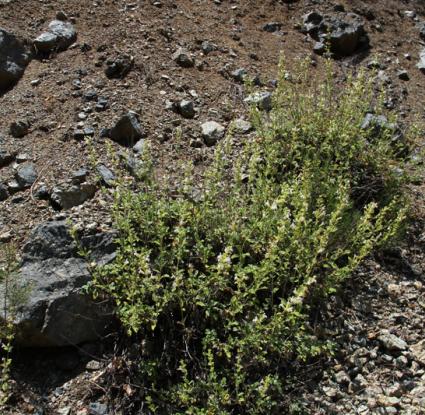Name - Origin
An aromatic shrub (Yangoullis 2014, entry σφατσ̆a - σπατσ̆α,η, 527), specifically, this is sage (Kypri 1983 [2003²], entry σπατζ̆ιά,η, 278; Yangoullis 2014, entry σφατσ̆α - σпаτσ̆α,η, 527; Petrou-Poeitou 2013, entry Σπατζιά, 141). Ioannis Erotokritos, characteristically, notes in his Glossary that it is the sage plant, a species of shrubby, aromatic plant (Kypri 1979 [2002²], entry σπατζ̆ιά,η, 231).
ETYM. < ancient sphakos (Yangoullis 2014, entry σφατσ̆ά - σπατσ̆ά,η, 527; Petrou-Poeitou 2013, entry Σπατζιά, 141)
Scientific name: Salvia cypria, Salvia libanotica (Kypri 1983 [2003²], entry σπατζ̆ιά,η, 278)
In other places, it is called hahomiliá, sfatzia and in Pitsilia area it is called aspatz̆iá (Kypri 1983 [2003²], entry σπατζ̆ιά,η, 278).
They used to boil it (Kypri 1983 [2003²], entry σπατζ̆ιά,η, 278)
Functional and symbolic role
The leaves and seeds of the plant are used to make tea, which is fragrant and was preferred by many in the past even over traditional tea (Kypri 1983 [2003²], entry σπατζ̆ιά,η, 278).
Additional information and bibliography
Yangoullis K. G. (2014), Θησαυρός Κυπριακής Διαλέκτου. Ερμηνευτικό, Ετυμολογικό, Φρασεολογικό και Ονοματολογικό Λεξικό της Μεσαιωνικής και Νεότερης Κυπριακής Διαλέκτου, Βιβλιοθήκη Κυπρίων Λαϊκών Ποιητών, Theopress Publications, Nicosia.
Kypri Th. D. (ed.) (1979 [2002²]), Υλικά διά την σύνταξιν ιστορικού λεξικού της κυπριακής διαλέκτου, Μέρος Α΄, Γλωσσάριον Γεωργίου Λουκά, Publications of the Centre for Scientific Research, XLI, Nicosia.
Kypri Th. D. (ed.) (1983 [2003²]), Υλικά διά την σύνταξιν ιστορικού λεξικού της κυπριακής διαλέκτου, Μέρος Β΄, Γλωσσάριον Ξενοφώντος Π. Φαρμακίδου, Publications of the Centre for Scientific Research, IX, Nicosia.
Petrou-Poeitou E. (2013), Από πού κρατάει η σκούφια τους. Λέξεις και ιστορίες από τον κόσμο της γεύσης, Epiphaniou Publications, Nicosia.
Stalo Lazarou, Argyro Xenophontos, Tonia Ioakim.

